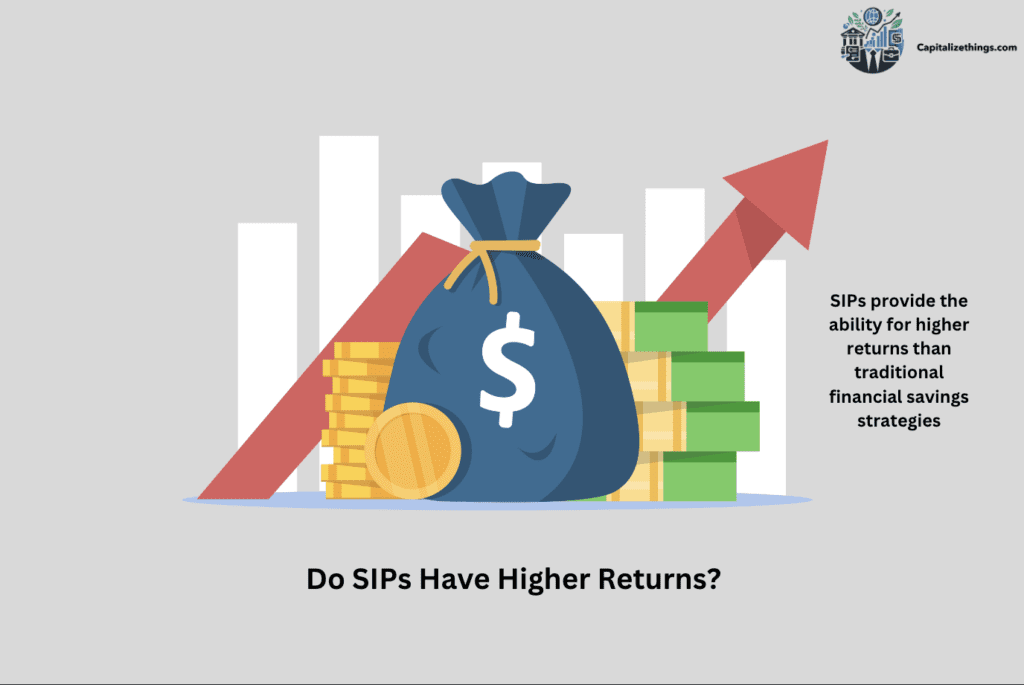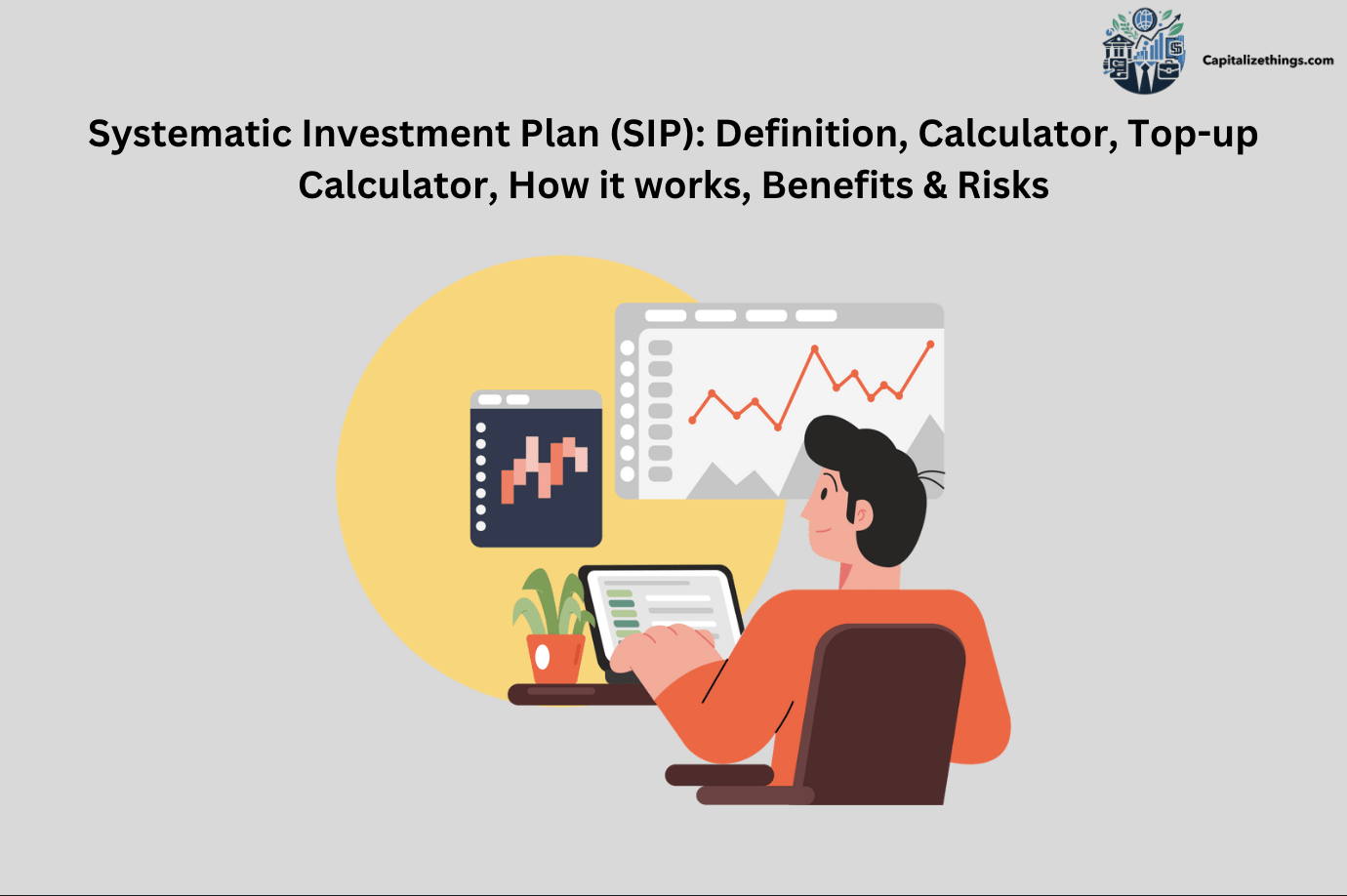A Systematic Investment Plan (SIP) is a way of making an investment a hard and fast sum regularly in mutual finances. Investors contribute at set intervals, normally monthly or quarterly. This method lets in for disciplined investing and enables average out market fluctuations. It’s a convenient way to build wealth over time, making it famous among investors. A SIP calculator allows estimating the destiny cost of investments based totally on periodic contributions, the fee of return, and the investment duration. Input the quantity invested often, predicted annual return, and length.
The calculator affords an estimate of the wealth created over time, permitting investors to plot and modify contributions in step with their goals. A SIP pinnacle-up calculator estimates the destiny fee of an investment when periodic contributions boom over time. Investors can enter the initial quantity, annual pinnacle-up percentage, predicted return, and length. The calculator indicates how adding greater funds periodically boosts capability returns. It’s useful for those trying to gradually increase their funding as their earnings grow. In a SIP, buyers select a mutual fund and set up ordinary contributions. These contributions buy more gadgets of the fund, no matter marketplace situations.
Over time, as the investment grows, the returns are compounded. This technique reduces the danger of marketplace timing, promotes disciplined making an investment, and makes it less difficult to attain monetary desires with smaller, regular investments. SIP offers several benefits, which include disciplined investing, rupee value averaging, and the electricity of compounding. It requires small investments, making it available to all. SIPs are bendy, allowing buyers to begin, stop, or alternate contributions effortlessly.
They assist in handling marketplace volatility, as investments unfold out over the years, decreasing the chance of making negative investment selections based totally on market timing. While SIPs are usually taken into consideration low-risk, they nonetheless deliver a few risks. Market fluctuations can affect returns, specifically inside the short term. The fulfillment of SIPs relies upon the overall performance of the chosen mutual finances. Investors have to be conscious that past overall performance does not guarantee destiny effects.
Grow your wealth on autopilot with SIPs! CapitalizeThings.com (+1 (323) 456-9123) guides you on setting up a winning SIP strategy. Schedule a free consultation today!
What is Systematic Investment Plan (SIP)?
A Systematic Investment Plan (SIP) lets you make investments a fixed amount of money often. You put money into a mutual fund at everyday intervals. The cash buys units on the fund’s Net Asset Value (NAV). It allows retail investors to grow wealth through the years. SIPs are a nice way to invest small sums of cash frequently.
What Is The SIP Approach?
The SIP approach involves making an investment a set quantity at ordinary durations, like month-to-month. This plan uses dollar fee averaging, where you invest the same dollar amount no matter marketplace charges. You buy more devices whilst fees are low and fewer whilst excessive. This disciplined funding approach helps you make investments consistently. It additionally reduces the hazard of market timing. The power of compounding helps your funding grow through the years. This technique is easy and suitable for retail investors who can make investments with small sums of money.
What Is The Objective Of SIP?
The Objective of a SIP is to assist traders build wealth over the years with small sums of money. By making an investment a hard and fast quantity at ordinary periods, buyers use dollar value averaging to manipulate marketplace fluctuations. SIPs intention to provide lengthy-time period growth via making disciplined investments. The plan works well for retail buyers who want to make investments often without traumatic marketplace prices. The energy of compounding increases the funding’s fee over time. SIPs make it simpler for traders to reach their financial dreams with no need for big sums of money prematurely.
What Are The 5 Types Of SIP?
The 5 types of SIPs are:
- Everyday SIP
- Top-up SIP
- Perpetual SIP
- Flexible SIP
- Trigger SIP
These five forms of Systematic Investment Plans (SIPs) are offered by mutual fund companies. The everyday SIP involves regular investments of a fixed amount. Top-up SIPs allow increasing the investment amount over time. Perpetual SIPs have no end date. Flexible SIPs permit changing the investment amount. Trigger SIPs initiate investments when specific market conditions are met. Each type provides unique benefits tailored to different investor needs.
How To Calculate SIP Using The Calculator?
To calculate SIP, use a SIP calculator. Enter the constant quantity you invest at ordinary intervals, the expected return, and the length. The calculator shows how your funding grows over time with the energy of compounding. To calculate a top-up SIP, input the growth in your investment quantity at every interval. This indicates how adding extra money can boost your returns. Both calculators help you plan your funding. They display how disciplined investments can construct wealth over time with small sums of money.
Advanced SIP Calculator with Top-up
What Are The Key Terms For Calculating Systematic Investment Plans?
When calculating SIPs, key phrases consist of the fixed amount you make investments, the ordinary c program language period, and the anticipated return. Net asset cost (NAV) is crucial because it determines what number of units you buy. Dollar cost averaging is the approach used to unfold out investments. The power of compounding facilitates the investment develop over time. Market fee affects returns. These terms are crucial to apprehend whilst planning your SIP. Retail buyers need to realize those phrases to make the most in their funding.
What Is The Excel Formula For Calculating Sip?
To calculate SIP in Excel, use the formula: FV(rate, nper, pmt, pv). Rate is the predicted return divided by means of the quantity of durations. Nper is the overall quantity of intervals. Pmt is the constant quantity invested at ordinary intervals. PV is the present cost, which is typically 0. These components help calculate the future fee of your SIP. It uses greenback fee averaging to estimate how small sums of money develop over time. This system is easy and useful for planning investments.
How Does A Systematic Investment Plan Work?
A Systematic Investment Plan works via investing a fixed quantity at regular periods in a mutual fund. Investors purchase more gadgets when the internet asset value is low and less when it’s far excessive. This plan uses dollar value averaging to lessen the impact of market fluctuations. The strength of compounding helps the investment grow through the years. This disciplined funding approach is easy for retail investors. It’s a simple way to invest small sums of cash regularly. Over time, this approach allows buyers to build wealth.
What Is SIP And SWP In Mutual Funds?
SIP (Systematic Investment Plan) and SWP (Systematic Withdrawal Plan) are two one-of-a-kind methods of coping with mutual price ranges. SIP lets you make investments a hard and fast amount at regular periods. This makes use of dollar cost averaging to grow your funding over the years. SWP, on the other hand, lets you withdraw a hard and fast quantity regularly. This provides earnings at the same time as retaining your funding. Both are offered by way of mutual fund groups. SIP is for constructing wealth; SWP is for taking flight. Both use a disciplined investment technique.
Is Stock SIP Good For Investment?
Stock SIPs are an excellent desire for buyers who aim for long-time period growth with disciplined making an investment. By making normal contributions, even in risky markets, investors can benefit from dollar value averaging. This approach enables reducing the effect of marketplace fluctuations. The electricity of compounding through the years can flip small sums into giant wealth. Prominent issuers of stock SIPs include ICICI Prudential Regular Savings Fund, Mirae Asset Large Cap Fund, and Axis Growth Opportunities Fund. These finances offer numerous possibilities acceptable to specific threat stages, permitting buyers to align their investments with their economic dreams.
Investing in inventory SIPs via famous finances inclusive of HDFC Flexi Cap Fund, SBI Bluechip Fund, and DSP Midcap Fund offers diversification across big-cap, mid-cap, and small-cap stocks. This varied technique balances risk and potential returns, making inventory SIPs a super choice for retail traders looking for consistent wealth creation. Other top-notch finances, like HDFC Balanced Advantage Fund and Nippon India Small Cap Fund, provide precise strategies to meet precise investment wishes. By choosing the proper SIPs, buyers can build a robust, assorted portfolio that grows consistently through the years, ensuring they meet their long-time period monetary goals.
What Is The Best Stock For SIP?
The satisfactory inventory for a Systematic Investment Plan (SIP) is one that plays nicely through the years. It is vital to put money into an inventory with good increase potential. Mutual fund agencies provide stocks with robust basics. These stocks provide stable returns. Retail investors must choose stocks with a solid track record. An inventory with an excessive net asset value (NAV) might be an excellent desire. This ensures that small sums of cash invested at ordinary periods via a disciplined funding method can grow. The energy of compounding can assist your money grow. SIPs paintings properly with the right stock. Always studies earlier than making an investment. Choose an inventory with a great marketplace price. Dollar fee averaging can help lessen risk while buying shares. SIPs paintings are nice with lengthy-time period desires. A suitable stock can improve your SIP returns.
Is SIP Good For Wealth Creation?
SIP is good for wealth advent. SIPs will let you invest small sums of money regularly. This allows building wealth through the years. A fixed amount at everyday intervals buys gadgets of a mutual fund at unique prices. This procedure is referred to as dollar value averaging. It reduces the impact of market fluctuations. Retail buyers find SIPs easy to manipulate. Mutual fund agencies offer many SIP alternatives. Investing in a disciplined investment plan like SIP takes advantage of the power of compounding.
This can develop your investment greenback via dollar. Over time, your investments can add up. Wealth advent with SIP is gradual but regular. SIPs are a scientific way to create wealth. They are exact for those who want to make investments without taking large risks. SIPs paintings well with lengthy-term desires.
What If I Invest $1,000 A Month In SIP?
If you invest $1,000 a month in a SIP, you could build wealth over time. SIPs can help you make investments in small sums of money frequently. You buy gadgets of a mutual fund at distinctive charges. This is referred to as dollar value averaging. It reduces the danger of market fluctuations. Over time, your funding can grow via the strength of compounding. Investing a hard and fast amount at regular intervals is a disciplined funding approach.
A 401(k) is an instance of a SIP-like plan. Investing in an amazing mutual fund can boost your returns. Mutual fund companies provide many SIP options. Your $1,000 investment can upload up over time. SIPs are a clever way to invest without taking massive risks. The secret to staying invested for a long time. SIPs work quality while you make investments frequently.
What Is SIP Presentation?
A SIP presentation explains how a Systematic Investment Plan (SIP) works. It suggests how you can invest small sums of money regularly in mutual funds. The presentation covers the advantages of SIPs. It explains the energy of compounding. The presentation also talks about greenback cost averaging. This reduces the effect of marketplace fluctuations. It shows how SIPs are a disciplined investment approach. The presentation also consists of examples of ways SIPs work.
It indicates how making an investment a set amount at normal intervals can grow your cash. Retail buyers can discover ways to use SIPs for wealth introduction. The presentation might also cowl the risks of SIPs. It explains how to pick out the proper mutual fund. A right SIP presentation is simple to apprehend. It enables buyers to make knowledgeable decisions. SIP displays are beneficial for each new and experienced investor.
How Is A DCA Strategy Better Than SIP Strategy?
DCA and SIP are essentially the same strategy, with DCA being a broader term that includes SIP as one specific implementation. Dollar cost averaging (DCA) is a strategy wherein you invest equal bills through the years. SIP is a shape of DCA however with a focal point on mutual funds. DCA can be used for any investment, not just mutual funds. DCA is flexible. You can invest in one-of-a-kind belongings. SIP is less bendy. It is tied to mutual fund corporations. DCA allows you to shop for extra while charges are low. This can lower the cost of your funding. SIPs work the identical manner but are limited to mutual funds.
Both techniques use the strength of compounding. DCA can also provide greater control over your investments. SIPs are less difficult to manipulate. Retail traders locate each strategy useful. The key distinction is flexibility. DCA gives greater alternatives. SIPs are extra structured. Both strategies can help develop your wealth.
How Does A Dividend Reinvestment Plan Help In SIP?
A dividend reinvestment plan (DRIP) helps in SIP with the aid of allowing dividends to buy greater devices. This is like how SIPs work. Both use the strength of compounding. A DRIP can improve your SIP returns. When dividends are reinvested, they buy extra gadgets of the mutual fund. This provides your funding. Over time, this will grow your wealth.
DRIPs are a disciplined investment method. They work properly with SIPs. Retail buyers find DRIPs useful. They allow you to invest small sums of cash often. DRIPs lessen the impact of market fluctuations. This is like greenback price averaging. Mutual fund groups offer DRIPs as part of their SIP plans. A DRIP can make your SIP more powerful. SIPs with DRIPs are proper for lengthy-term wealth advent.
What Is An Example Of SIPs?
An Example of a Systematic Investment Plan (SIP) is whilst an investor decides to invest $200 each month into a mutual fund. The investor sets up an automated debit from their financial institution account, in which $200 is deducted and invested in the selected mutual fund every month on a specific date. Over the path of a yr., the investor could make contributions $2,400 to the fund. If the mutual fund’s Net Asset Value (NAV) fluctuates, the investor buys more units whilst the NAV is low and fewer devices whilst the NAV is excessive. This process, known as greenback fee averaging, enables reducing the effect of marketplace volatility at the funding.
What Are The Benefits And Risks Of Using SIPs?
SIPs offer many blessings, such as disciplined funding and the ability to make investments small sums of money often. They allow buyers to shop for extra units whilst expenses are low, way to dollar cost averaging. SIPs additionally take gain of the power of compounding, leading to ability lengthy-time period wealth advent. They are bendy, permitting buyers to start, stop, or adjust their investments at any time. SIPs are easy to control, making them perfect for retail buyers.
Despite their benefits, SIPs convey dangers. Market volatility can influence returns, mainly in the brief time. The fulfillment of a SIP depends on the overall performance of the mutual fund selected. Poorly acting funds can result in losses. Additionally, SIPs require a long-time period dedication to reap favored outcomes. Investors can also face possibility fees if they miss out on high returns from different investments. SIPs aren’t appropriate for those searching for short returns.
| Pros | Cons |
| Disciplined investment | Market volatility can impact returns |
| Small sums of money invested regularly | Depends on mutual fund performance |
| Dollar cost averaging reduces the impact of market fluctuations | Requires long-term commitment for optimal results |
| Power of compounding can lead to significant wealth creation | Potential opportunity cost from missing other high-return investments |
| Flexible, allowing adjustments to investment amounts | Not suitable for investors seeking quick returns |
What Is The Difference Between Systematic Investment Plan And Lump Sum Plan?
The predominant distinction among a Systematic Investment Plan (SIP) and a lump sum plan lies inside the funding technique. In a SIP, traders contribute a hard and fast quantity at everyday periods, including month-to-month or quarterly. This technique allows for greenback cost averaging, in which the investor buys more devices whilst expenses are low and less gadgets whilst expenses are excessive. SIPs are best for retail traders who pick disciplined investment strategies and need to make investments small sums of cash through the years. They also are appropriate for folks that need to benefit from the energy of compounding and spread their funding threat over time.
A Lump sum plan involves investing a large sum of money immediately. This approach is appropriate for traders who’ve a sizable quantity of capital and are assured inside the marketplace’s cutting-edge conditions. A lump sum funding can yield better returns if the marketplace performs well, however it additionally contains higher dangers. If the market declines after the investment, the investor also faces vast losses. Lump sum investments do not benefit from dollar cost averaging, making them greater prone to marketplace fluctuations. While SIPs provide a more systematic and gradual technique, lump sum investments greater profitable in a good marketplace however additionally riskier.
What Is a Systematic Investment Plan (SIP) In Mutual Funds?
A Systematic Investment Plan (SIP) in mutual funds is a way to spend money on a combination of assets like stocks and bonds frequently. Instead of creating a one-off transaction, you make contributions a fixed amount at set intervals, which includes month-to-month. This method allows you to build a portfolio that aligns together with your investment targets, whether you are inquisitive about small-cap stocks, bonds, or finances tracking the S&P 500 index.
SIPs are specifically beneficial for those who want to budget for retirement. By making an investment gradually over the years, you can gather holdings that develop with the strength of compounding. A buying and selling accounts are needed to install a SIP. Financial advisors frequently suggest SIPs for retail buyers because they offer a disciplined approach to investing. SIPs assist you manipulate market volatility and stick to your funding dreams, making them a robust desire for long-term wealth introduction.
What Is a SIP Method In Mutual Funds?
A Systematic Investment Plan (SIP) is a way to invest in a mutual funds. SIPs allow traders to put in a set amount at ordinary intervals. This technique facilitates retail traders to buy mutual fund devices on the net asset cost. SIPs use greenback cost averaging, which spreads the value over time. Investors make equal payments with small sums of money, making it clean to start. SIPs are a disciplined investment method that fits 401(ok) plans and different funding greenback strategies. The strength of compounding enables growth of investments through the years. SIPs are supplied with the aid of mutual fund companies and assist clean out market fee fluctuations. Investors gain from investing often without timing the market, making it a systematic and price-powerful plan.
Is SIP Better Than FD?
SIPs and Fixed Deposits (FDs) are each famous approaches where SIP can potentially offer higher returns than FD, but comes with greater market risk. SIPs permit investing in mutual funds with periodic identical bills. They offer the hazard for better returns via market-linked investments. SIPs use dollar cost averaging, shopping for more units when the market charge is low. FDs offer constant returns, making them more secure but with lower capacity gains. SIPs benefit from the energy of compounding, supporting small sums of money to grow over time. In evaluation, FDs give constant returns without market risks. SIPs suit the ones looking for a boom, at the same time as FDs are for conservative savers. Retail traders regularly pick SIPs for long-term desires. The desire between SIPs and FDs relies upon chance tolerance and funding dreams.
Do SIPs Have Higher Returns?
SIPs provide the ability for higher returns than traditional financial savings strategies. By making an investment a hard and fast quantity at ordinary durations, buyers gain from dollar value averaging. This approach buys extra gadgets whilst the marketplace rate is low. Over time, the energy of compounding boosts returns on SIPs.
Compared to fixed deposits, SIPs have a better chance however can supply more profits. SIPs are connected to market overall performance, so returns vary. Mutual fund corporations offer various price ranges to match one-of-a-kind hazard degrees. Investors searching for growth frequently find SIPs profitable. SIPs offer a disciplined investment approach with the capacity for great returns. The key is selecting the proper mutual funds and staying invested over the long term.

Which Is Best SIP Or SWP?
SIP is generally better for wealth accumulation, while SWP is better for regular income from existing investments. SIPs and SWPs serve specific funding dreams. SIPs involve investing a fixed quantity frequently in mutual price range, whilst SWPs (Systematic Withdrawal Plans) permit periodic withdrawals. SIPs consciousness on developing wealth over the years via disciplined investment.
They use greenback price averaging and the energy of compounding to maximize returns. SWPs offer regular profits, making them ideal for retirees or the ones wanting consistent coins glide. SIPs fit those seeking to construct wealth, while SWPs are for those needing to get right of entry to the budget. Both methods contain mutual fund groups and depend on the market charge. Investors should select based on their monetary desires and desires. SIPs are for increase, while SWPs are for income.
Can I Withdraw SIP Anytime?
SIPs provide flexibility, permitting investors to withdraw their investments anytime. This feature fits retail investors who would possibly want funds. Withdrawals depend on the internet asset value on the time, reflecting the modern market rate. SIPs do not lock in price range, unlike constant deposits. However, taking flight early would possibly affect the strength of compounding. Investors must remember their financial desires before making withdrawals.
Mutual fund corporations typically permit clean admission to funds, however a few additional fee exit prices. SIPs fit those desiring each increase and liquidity. It’s critical to understand the phrases and situations of each SIP before making an investment. SIPs provide a disciplined investment technique with the benefit of flexibleness.
Is SIP A Beginner Investor Friendly Strategy?
SIPs are noticeably newbie-pleasant, making them ideal for brand new traders. This method entails investing small sums of money at constant everyday periods, easing the technique of getting started. SIPs use greenback fee averaging, which facilitates novices to avoid the pitfalls of marketplace timing. Retail buyers can build a portfolio without having to make investments big sums prematurely.
The benefit of compounding boosts returns over the years, making SIPs a disciplined investment desire. SIPs are easy to set up with mutual fund corporations and do no longer require deep market information. Beginners can regularly boost their investments as they gain self-assurance. SIPs provide a straightforward way to begin making an investment, making them ideal for rookies to the market.
What Companies In Us Use SIP?
Many corporations inside the US offer SIPs, making it smooth for buyers to begin. Mutual fund businesses like Vanguard, Fidelity, and T. Rowe Price provide SIP options for retail buyers. These businesses permit traders to make a small sum of money at everyday durations. SIPs also are popular in retirement plans, including 401(k)s. These plans use greenback fee averaging and provide disciplined funding alternatives. SIPs are designed to develop wealth regularly over the years, profiting from the energy of compounding. Mutual fund companies install SIPs to help investors meet their lengthy-time period dreams. US companies that provide SIPs recognition on making an investment reachable and easy, with a whole lot of funds to choose from.
What Are The Principles Of Investment Using SIP?
Investment principles using SIP revolve around consistency and area. SIPs contain investing a fixed amount at ordinary intervals, together with monthly or quarterly. This method promotes disciplined investment, supporting retail traders to build wealth through the years. SIPs use greenback cost averaging, which averages the price of investments over time, decreasing the impact of market fee fluctuations.
The energy of compounding boosts returns, making SIPs a smart lengthy-time period approach. SIPs are bendy, permitting investors to start with small sums of cash. Mutual fund groups provide a huge range of SIP options to match distinctive chance profiles and desires. The key ideas of SIP funding consist of ordinary contributions, lengthy-time period attention, and staying invested to maximize returns.
Do Investors Using SIP Strategy Pay Taxes?
Yes, buyers who use the SIP strategy must pay taxes on their profits. Taxation depends on the kind of mutual fund and the keeping duration. Equity mutual funds held for more than one year entice lengthy-term capital gains tax. For debt mutual finances, an exclusive tax price applies. SIP investments aren’t exempt from taxes, so traders should not forget this when making plans.
Mutual fund groups normally offer specified tax information to assist traders. The power of compounding can assist offset some tax burdens with the aid of developing the investment over time. Retail investors need to visit tax professionals to apprehend their obligations. SIPs offer a disciplined funding approach, but taxes continue to be a critical consideration.
What Are The Major Investment Opportunities Using SIP?
SIPs offer investment opportunities in mutual funds, stocks, bonds, and index funds. Investors can pick out from equity mutual funds, debt price range, or balanced funds, relying on their threat tolerance. Equity mutual price ranges offer high growth capacity however include market rate dangers. Debt price ranges offer solid returns with lower chance, appropriate for conservative traders. Balanced price range blends equity and debt, offering mild boom with reduced threat.
SIPs use dollar cost averaging, which blesses retail investors in unstable markets. The energy of compounding boosts returns, making SIPs a disciplined funding choice for long-term desires. Mutual fund corporations provide a huge range of SIPs, allowing investors to diversify throughout sectors and asset training.
Can A Gold Investment Company In China Use SIP?
Yes, a gold investment business enterprise in China can use SIPs. SIPs aren’t constrained to mutual finances; they can also be used to spend money on gold. Using SIPs, buyers can buy gold at ordinary durations, benefiting from dollar price averaging. This technique spreads the funding value over the years, lowering the effect of market price fluctuations.
Gold investment agencies in China can provide SIPs to retail buyers trying to spend money on gold with small sums of money. SIPs provide a disciplined funding approach, allowing for the gradual accumulation of gold. The electricity of compounding is no longer observed in gold; however SIPs nevertheless provide a systematic and value-effective manner to make investments.
What Investment Instruments Are Useful With SIP Strategy?
Mutual funds, especially equity and balanced funds, are most commonly used with SIP strategies. Mutual funds are the most not unusual, supplying equity, debt, and balanced options. SIPs in equity mutual funds offer excessive growth capability, at the same time as debt finances provide stability. Balanced finances mix both, lowering hazards.
Exchange-traded price range (ETFs) are also suitable for SIPs, supplying diversification with lower prices. SIPs can be used to put money into gold, both through gold budget or direct purchases. SIPs involve periodic equal payments, making them available to retail traders. The energy of compounding complements returns in equity and balanced finances. SIPs are flexible, allowing traders to build a various portfolio across one-of-a-kind gadgets.
Should An Investor Diversify Its Portfolio Using Only SIPs Strategy?
An investor can diversify a portfolio using only the SIP method. SIPs permit for investing in one-of-a-kind kinds of mutual finances, inclusive of equity, debt, and balanced funds. This diversification enables unfolding hazards throughout numerous asset lessons. Equity price range offers high increase, whilst debt finances provide stability. SIPs use dollar cost averaging, which reduces the impact of marketplace fee fluctuations. The power of compounding will increase returns through the years, especially in equity budget.
Retail investors can start with small sums of money and steadily construct a diversified portfolio. SIPs are a disciplined investment technique, making them suitable for those trying to diversify without making big lump-sum investments.
Can We Stop Our Investments In SIPs Anytime?
Yes, investors can stop their investments in SIPs each time. This flexibility makes SIPs appealing to retail buyers. If economic wishes change, buyers can halt their SIP contributions without consequences. However, stopping SIPs might influence the power of compounding and lengthy-time period returns.
The funding dollar plan in SIPs relies upon normal contributions to maximize advantages. Mutual fund organizations allow easy adjustments to SIPs, consisting of preventing or lowering payments. SIPs are designed to be flexible, accommodating exclusive monetary conditions. Investors need to carefully don’t forget their dreams before preventing SIPs. While SIPs offer flexibility, retaining disciplined funding is key to achieving long-term economic targets.
Conclude:
A Systematic Investment Plan (SIP) offers a disciplined and bendy method to investing, making it suitable for a wide range of buyers. By investing a hard and fast amount at regular intervals, SIPs make use of dollar value averaging and the energy of compounding to decorate returns. They offer possibilities across diverse asset instructions, such as equity funds, debt, and gold. SIPs are accessible and useful for beginners and skilled buyers. While they provide many benefits, cautious choice of mutual funds and expertise, the associated risks are crucial for attaining long-time economic desires.
How can we help?
If you are tired of missing investment opportunities than CapitalizeThings.com sets you on autopilot with a winning SIP strategy. We provide Free Consultation if you reach out to us filling the form at the bottom and share your goal and situation.

Larry Frank is an accomplished financial analyst with over a decade of expertise in the finance sector. He holds a Master’s degree in Financial Economics from Johns Hopkins University and specializes in investment strategies, portfolio optimization, and market analytics. Renowned for his adept financial modeling and acute understanding of economic patterns, John provides invaluable insights to individual investors and corporations alike. His authoritative voice in financial publications underscores his status as a distinguished thought leader in the industry.







